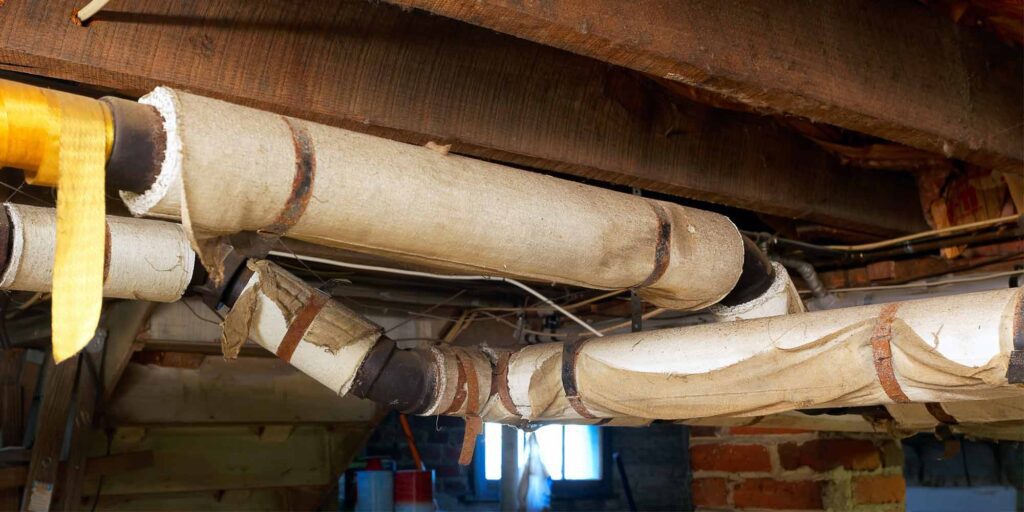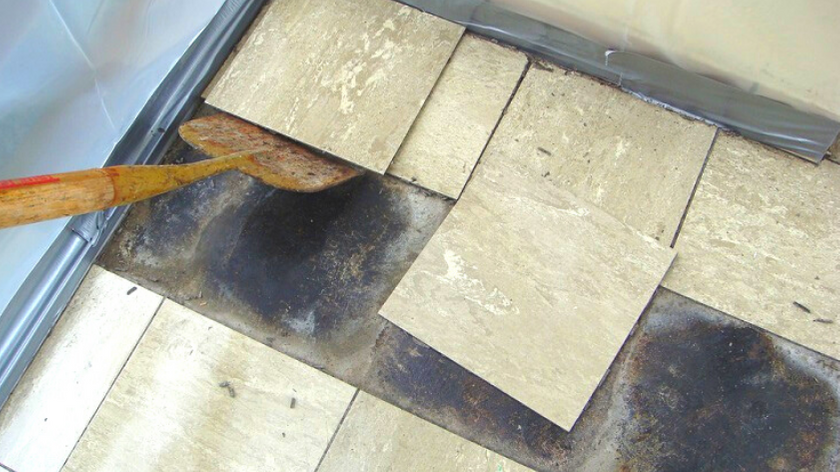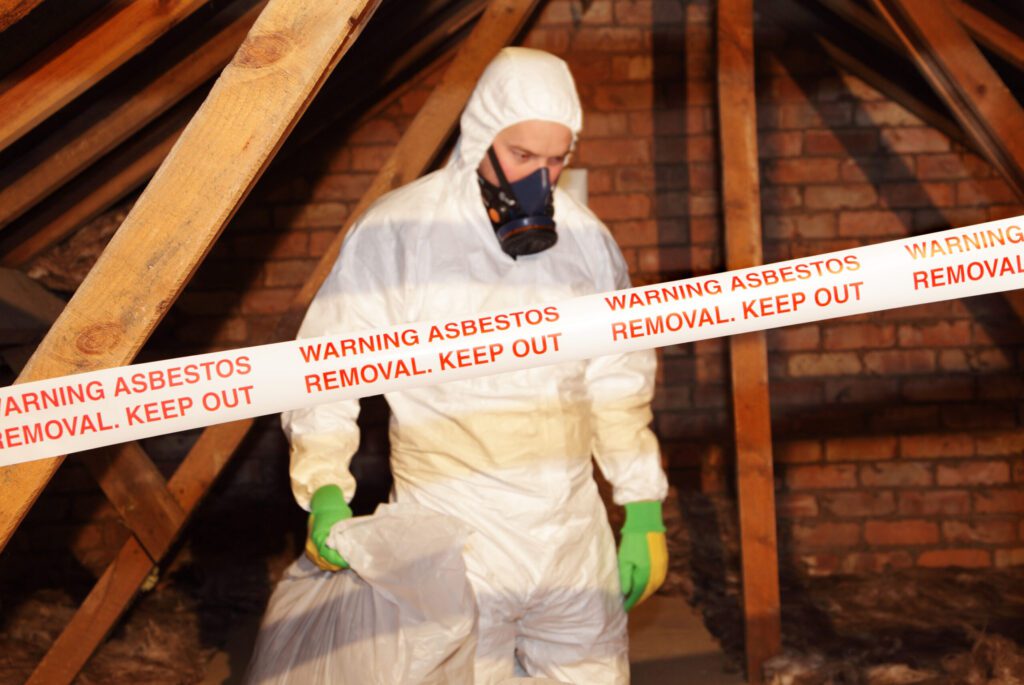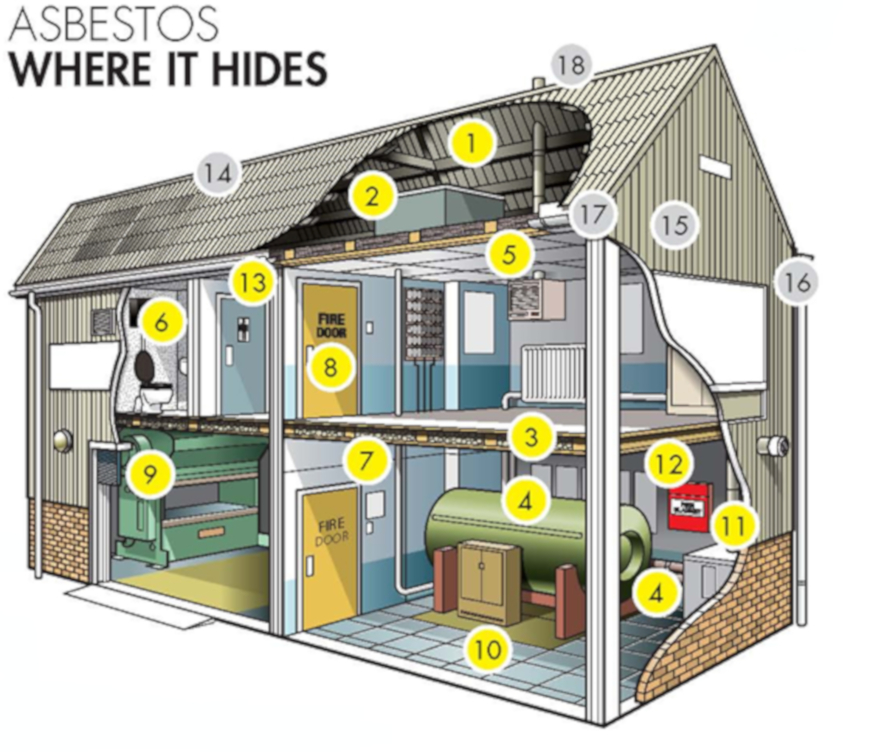Is your home hiding a danger? What does asbestos looks like?
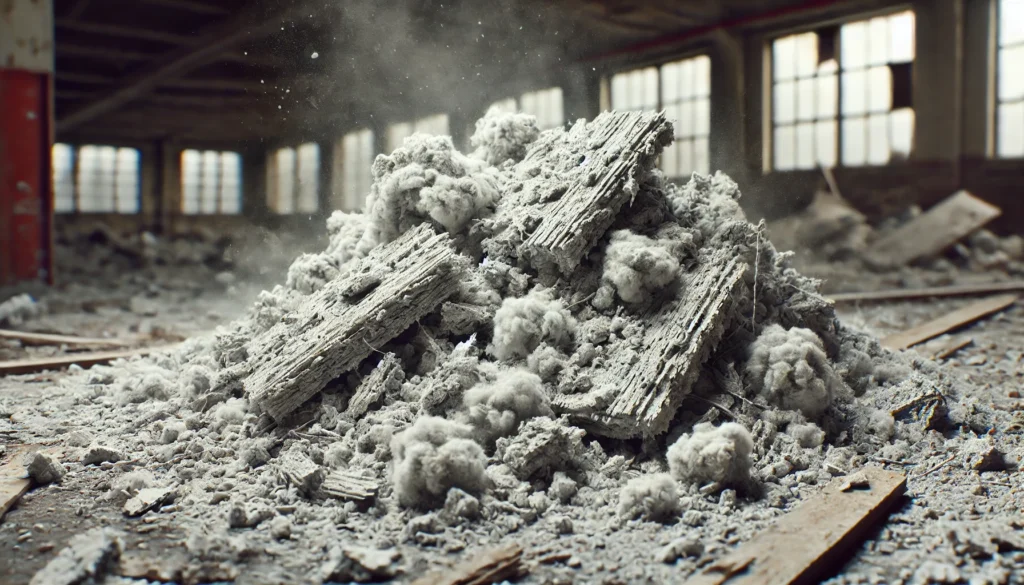
What Does Asbestos Look Like
Are you worried about potential asbestos exposure in your home? Did you know that this hazardous material can lurk anywhere from floor tiles to insulation? Our comprehensive guide will help you recognize what asbestos looks like and where it’s commonly found.
Stay with us, and be one step ahead in ensuring a safer living environment for your family.
Expert Quote: “Asbestos is a chameleon in the construction world. Its appearance can vary widely depending on its form and what it’s mixed with. The key takeaway is that you can’t always identify it by sight alone. Professional testing is essential for a definitive answer.”
— Nica Louie, Environmental Health Scientist
Key Takeaways
- Asbestos can appear blue, brown, or white in color and is often soft to the touch.
- It comes in different types: non-friable (doesn’t break easily) and friable (breaks down into dust).
- Asbestos fibers are small and light, can float in the air if disturbed, and can be harmful if inhaled.
- Common materials containing asbestos include boards, insulation, sprayed coating, textiles, gaskets/washers, cement, paper, vinyl flooring/wallpaper/resin/coating.
What Does Asbestos Look Like?
Asbestos can appear blue, brown, or white in color and is often soft to the touch, unless it is part of a compound material.
Blue, brown, or white in color
Asbestos comes in different colors. You may see it as blue, brown, or white. These shades tell us about the type of asbestos. Blue and brown are often thought to be more harmful than white.
But all types can harm your health if you breathe them in. Even tiny bits can cause damage, so always treat any kind of asbestos with care.
Non-friable vs. friable asbestos
Asbestos can be of two types. One is non-friable and the other is friable. Non-friable asbestos does not break easily. It stays solid most of the time. If it’s left alone, it’s less likely to cause harm.
On the other hand, we have friable asbestos. This type breaks down easily into dust or powder when touched or moved. Once broken, small particles become airborne and can be inhaled by people nearby.
Expert Quote: “The distinction between friable and non-friable asbestos is crucial. Friable asbestos can easily become airborne, making it much more dangerous. However, even non-friable asbestos can become friable if it’s damaged, so caution is always advised.”
— Shannon Devine, Certified Asbestos Inspector
Soft to the touch (unless in compound material)
Asbestos feels soft to touch. This is true when it’s not mixed with other materials. Its fibers are smooth like silk threads. But, asbestos in things like cement or insulation is rougher.
It depends on what the asbestos is mixed with. So, don’t rely only on how it feels to find out if something has asbestos.
Small and light fibers that can float in the air
Asbestos particles are small and light, so they can easily float in the air. This means that if materials containing asbestos are disturbed or damaged, these fibers can become airborne and potentially be inhaled by people nearby.
It’s important to be cautious around any materials suspected of containing asbestos to avoid exposure to these harmful fibers.
Common Asbestos-containing Materials
Asbestos can be found in various materials such as asbestos boards, thermal insulation, sprayed insulation, textiles, gaskets and washers, cement, paper, vinyl, resin, and decorative coatings.
Click here to learn more about these common materials and how to identify them.
Expert Quote: “Asbestos was once hailed as a ‘miracle material’ for its fire-resistant properties, which is why it’s so pervasive in older homes. From insulation to floor tiles, it’s more common than most people realize.”
— Tim Nelson, Industrial Hygienist
Asbestos boards
Asbestos boards are a type of construction material that was commonly used in older homes. These boards are typically gray or brown in color and have a hard, solid texture. They may also have a rough, fibrous surface.
It’s important to note that asbestos boards can be found in various areas of the home, such as walls, ceilings, and even under flooring. If you suspect that your home may contain asbestos boards, it is crucial to consult with a professional for testing and proper handling.
Remember to prioritize safety and take appropriate measures if asbestos is discovered.
Asbestos thermal insulation
Asbestos thermal insulation is a type of insulation material that was commonly used in homes and buildings in the past. It can be found in areas such as pipes, boilers, and ductwork.
Asbestos thermal insulation may appear as a soft, fluffy material that is white or light gray in color. It can easily release small fibers into the air if it becomes damaged or disturbed.
These fibers are very dangerous if they are inhaled, as they can cause serious health problems over time. If you suspect that your home has asbestos thermal insulation, it is important to have it checked by a professional and take appropriate steps to remove or manage it safely.
Asbestos sprayed insulation
Asbestos sprayed insulation was commonly used in older homes for its fire resistance and thermal properties. It can be found in attics, walls, and ceilings. Asbestos sprayed insulation is typically fluffy and light gray or brown in color.
The texture may resemble popcorn or cottage cheese. It is important to note that asbestos fibers from sprayed insulation can easily become airborne if disturbed, posing a health risk if inhaled.
Therefore, it is crucial to consult professionals for proper testing and removal of asbestos sprayed insulation to ensure the safety of your home and family.
Asbestos textiles
Asbestos textiles are materials that contain asbestos strands. They can be found in various household products, such as curtains, blankets, gloves, and even clothing. These textiles were commonly used in the past due to their fire-resistant properties.
However, it is important to note that asbestos textiles pose a serious health risk if they become damaged or deteriorate over time. When these materials are disturbed, tiny asbestos fibers can be released into the air and easily inhaled.
Asbestos textile products should be handled with extreme caution and professionals should be contacted for proper testing and removal if necessary.
Asbestos gaskets and washers
Asbestos gaskets and washers are commonly found in older homes. They were used in plumbing fixtures, valves, and other mechanical systems to create a tight seal. These materials are usually grey or white and can be quite thin.
It is important to be cautious around asbestos gaskets and washers because they can release harmful fibers if disturbed or damaged. If you suspect that your home contains asbestos gaskets or washers, it is best to consult a professional for testing and proper handling.
Asbestos cement
Asbestos cement is a common material that was used in construction. It looks like regular cement, but it contains asbestos particles. These fibers are small and light, and they can easily become airborne if the cement is disturbed.
Asbestos cement was commonly used in roofing sheets, pipes, and other building materials. If you suspect that you have asbestos cement in your home, it’s important to consult a professional for testing and to take the necessary precautions when handling or removing it.
Asbestos paper
Asbestos paper is a type of material that contains asbestos filaments. It was commonly used for insulation, packaging, and as a barrier to heat or fire. Asbestos paper can be found in older homes and buildings, particularly in areas like electrical panels, ductwork, or appliances.
It has a white or grayish color and is usually soft to the touch. If you come across asbestos paper in your home, it is important to avoid disturbing it as the fibers can become airborne and pose health risks if inhaled.
Instead, consult with professionals who can safely remove or manage the asbestos-containing material.
Asbestos vinyl
Asbestos vinyl is another common material that might contain asbestos. It was commonly used in floor tiles, linoleum, and even wallpaper. Asbestos vinyl can be difficult to identify without professional testing because it often looks like regular vinyl flooring or wallpaper.
If you suspect that your home has asbestos vinyl, it’s important to consult a professional for testing and to follow proper safety precautions before attempting any repairs or removal.
Asbestos resin
Asbestos resin is a type of material that contains asbestos fibers mixed with a binding agent like epoxy or plastic. It is commonly found in older building materials, such as adhesives, sealants, and coatings.
Asbestos resin can be hard to identify because it often looks like other non-asbestos materials. However, if you suspect that you have asbestos resin in your home, it’s important to consult a professional for testing and proper handling.
Exposure to asbestos can be harmful to your health, so it’s essential to take precautions and seek expert advice when dealing with this potentially dangerous material.
Asbestos decorative coating
Asbestos decorative coating is a type of material that was commonly used in homes for its fire-resistant properties. It can be found on walls, ceilings, and even on older furniture or fixtures.
This coating might have a textured or patterned appearance, and it could be painted over to match the décor of the room. However, it’s important to note that asbestos decorative coating can release dangerous fibers into the air when disturbed or damaged.
Therefore, it’s crucial to handle this material with caution and seek professional help if you suspect its presence in your home.
How to Identify Asbestos
Identify asbestos by conducting a visual examination, hiring professional asbestos testing services, or consulting experts in the field.
Visual examination
To visually examine materials for asbestos, you need to look for certain characteristics. Asbestos can come in different colors like blue, brown, or white. It may also appear as small and light fibers that can float in the air.
However, it’s important to note that asbestos may be difficult to identify just by looking at it. If you suspect there is asbestos present in your home, it’s best to consult a professional for testing or seek advice from experts who can accurately determine its presence.
Remember to prioritize safety and take necessary precautions when dealing with potential asbestos-containing materials.
Professional asbestos testing
Professional asbestos testing is an important step in identifying and confirming the presence of asbestos in your home. Visual examination can give you some indication, but to be certain, it’s best to hire a professional.
These experts have the knowledge and equipment to accurately detect asbestos fragments in various materials. They will take samples and send them to a certified laboratory for analysis.
Once the results are obtained, they will provide you with a detailed report that outlines the presence or absence of asbestos in your home. This information will help you make informed decisions about any necessary repairs or removals that need to be done to ensure the safety of your household.
Consulting experts
If you’re not sure whether something contains asbestos, it’s best to consult experts for their professional opinion. They have the knowledge and experience to identify asbestos correctly.
Visual examination can give some clues, but it’s always recommended to get professional asbestos testing done. This way, you can be sure about the presence of asbestos and take appropriate actions if needed.
Don’t hesitate to reach out to experts who specialize in asbestos identification and removal for accurate advice and guidance.
Where Is Asbestos Found?
Asbestos can be found in various places within homes, such as floor tiles, insulation board, siding, and even in popcorn ceilings. It is crucial to identify these potential sources to ensure the safety of your household.
Read more to learn about where asbestos may be hiding in your home.
Asbestos floor tiles
Asbestos floor tiles can be found in older homes, especially those built before the 1980s. These tiles are often square or rectangular and may have a vinyl or linoleum surface. They come in various colors like white, black, gray, or brown.
If your home has asbestos floor tiles, it’s important to handle them with caution as they can release harmful asbestos dust when disturbed. If you suspect that your floor tiles contain asbestos, consult a professional for testing and consider proper removal to minimize health risks.
Asbestos sprayed coating
Asbestos sprayed coating is a type of material that was commonly used for insulation purposes. It can be found in buildings, especially older ones. This coating contains asbestos material that are mixed with other materials like cement or adhesive.
The sprayed coating may appear as a fluffy or textured substance on surfaces like ceilings, walls, or pipes. It’s important to be cautious around this material because when it becomes damaged or disturbed, the asbestos fibers can become airborne and pose a health risk if inhaled.
If you suspect that your home has asbestos sprayed coating, it’s best to consult a professional for testing and removal if necessary to ensure the safety of you and your family.
Asbestos siding
Asbestos siding is a type of building material that was commonly used in the past. It can be found on the exterior walls of older homes. Asbestos siding is usually gray or white in color and has a smooth texture.
If your house has asbestos siding, it’s important to handle it carefully because asbestos fibers can be harmful if they are released into the air. If you suspect that your home has asbestos siding, it’s best to consult a professional for testing and to discuss proper removal options.
Asbestos artex/textured coating/popcorn ceiling
Asbestos can also be found in artex, textured coatings, or popcorn ceilings. These types of ceilings were commonly used in older homes and buildings. Asbestos was added to these materials for its fire-resistant properties.
If your home has these types of ceilings and they are damaged or deteriorating, it is important to have them tested for asbestos before making any repairs or renovations. Disturbing asbestos-containing materials can release harmful fibers into the air, which can pose serious health risks if inhaled.
It is best to consult a professional for testing and if necessary, hire a licensed asbestos removal contractor to ensure safe handling and proper disposal of the contaminated material.
Asbestos insulation board (AIB)
Asbestos insulation board (AIB) is another common material that can contain asbestos. It is often used for insulation purposes in walls, ceilings, and pipes. AIB may appear as a dense, brittle gray material that resembles flat cement sheets or plasterboard.
It can also have a smooth or textured surface. If you suspect the presence of AIB in your home, it is important to consult a professional for testing and take appropriate measures to ensure the safety of your family and prevent exposure to asbestos fibers.
Asbestos cement roofing sheets
Asbestos cement roofing sheets were commonly used in older homes as a durable and fire-resistant material. These sheets are typically gray or white and have a smooth surface. They may contain small fibers that can become airborne if the material is damaged or deteriorating.
It’s important to remember that asbestos dust and fibers can be harmful when inhaled, so it’s crucial to handle these roofing sheets with caution. If you suspect that your home has asbestos cement roofing sheets, it’s best to consult a professional for testing and appropriate steps to ensure safety.
Asbestos-containing storage heaters
Asbestos-containing storage heaters were commonly used in older homes for heating purposes. These heaters may have a coating or insulation that contains asbestos microfibers. Asbestos in these heaters can become friable and release dangerous fibers into the air when damaged or disturbed.
It is important to be cautious around these heaters and seek professional help if you suspect asbestos contamination.
Asbestos in fuse boxes
Asbestos can also be found in fuse boxes, which are electrical panels that control the distribution of electricity in your home. The presence of asbestos in old fuse boxes is a potential health hazard because when the material is disturbed during repairs or renovations, it can release harmful fibers into the air.
If you have an older home with a fuse box and suspect that it may contain asbestos, it’s important to consult a professional for testing and guidance on how to handle it safely.
Loose-fill asbestos insulation
Loose-fill asbestos insulation is a type of asbestos that was commonly used to insulate homes, especially in the attic or between walls. It looks like fluffy, loose material, often grayish or brownish in color.
The dangerous thing about it is that it can release small fibers into the air if disturbed. These fibers are very light and can easily be inhaled. So, if you suspect your home has loose-fill asbestos insulation, it’s important to take precautions and have it tested by a professional before making any changes to your home.
Why Is Asbestos a Problem?
Asbestos is a problem because it poses serious health risks and can lead to various diseases associated with asbestos exposure, which have a long latency period before symptoms appear.
Proper handling and removal of asbestos are crucial to prevent further harm.
Health risks and diseases associated with asbestos contamination
Exposure to asbestos can pose serious health risks and lead to diseases such as lung cancer, mesothelioma, and asbestosis. When asbestos fibers are inhaled or ingested, they can get trapped in the lungs and other organs, causing inflammation and scarring over time.
These diseases have a long latency period, meaning symptoms may not appear for many years after exposure. It’s important to handle asbestos-containing materials with caution and consult professionals for testing and safe removal if necessary.
Expert Quote: “The latency period for asbestos-related diseases can be decades long, making it a silent but extremely harmful contaminant. Early detection and intervention are key to mitigating long-term health risks.”
— Dr. Jonathan Kurman, Pulmonologist
Long latency period of asbestos-related diseases
Asbestos-related diseases can take a long time to develop, even decades after exposure. This is known as the latency period. It means that if you were exposed to asbestos many years ago, you may not see any symptoms or health problems right away.
In fact, it could be 20 to 50 years before anything shows up. This makes it difficult for people to connect their current health issues with past asbestos inhalation. So, it’s important to be aware of the risks and take necessary precautions if you think you’ve been exposed to asbestos in the past.
Importance of proper handling and removal
Proper handling and removal of asbestos is crucial to protect your health and the health of others. Asbestos fibers can be released into the air when materials containing asbestos are disturbed or damaged, and if inhaled, these fibers can cause serious respiratory diseases, including lung cancer and mesothelioma.
Therefore, it is important to hire professionals who are trained in asbestos removal to ensure that it is done safely and efficiently. DIY removal attempts can lead to the release of more fibers and put you at risk of exposure.
Remember, always prioritize safety when it comes to dealing with asbestos-containing materials.
Expert Quote: “DIY asbestos removal is a gamble with your health. The fibers are microscopic and can easily be inhaled. Always consult professionals for asbestos abatement to ensure it’s done safely and effectively.”
— James Leist, Certified Asbestos Abatement Contractor
What Should You Do If You Find Asbestos?
Consult a professional for testing, proceed with asbestos repair or removal, follow proper safety precautions, seek legal advice if necessary.
Expert Quote: “If you suspect your home contains asbestos, the first step is to leave it undisturbed and consult a professional. Disturbing asbestos-containing materials can release fibers into the air, increasing the risk of exposure.”
— Maya Nair, Legal Advisor specializing in Environmental Law
Consult a professional for testing
To accurately identify asbestos, it is best to consult a professional for testing. They have the knowledge and equipment to conduct proper inspections and sample analysis. Visual examination alone may not be enough as some materials may look similar to asbestos but do not contain the harmful substance.
Professional asbestos testing can provide definitive results, giving you peace of mind and ensuring your safety. If you suspect the presence of asbestos in your home, it’s essential to seek expert advice before taking any further action.
Proceed with asbestos repair or removal
If you find asbestos in your home, it’s important to take action. Consult a professional for testing to confirm its presence and determine the best course of action. If the asbestos is in good condition and not releasing fibers into the air, it may be possible to safely repair or encapsulate it.
However, if the asbestos is damaged or deteriorating, removal by a licensed professional is recommended to minimize exposure risks. Make sure to follow proper safety precautions during any work involving asbestos and seek legal advice if necessary.
Follow proper safety precautions
To ensure your safety and protect yourself from asbestos exposure, it is crucial to follow proper safety precautions. If you suspect the presence of asbestos in your home or any materials, avoid disturbing them as much as possible.
Do not touch or disturb any materials that may contain asbestos fibers, such as insulation or textured coatings. It is best to consult with a professional for testing and assessment before taking any further action.
When handling asbestos-containing materials, make sure to wear protective clothing like gloves and masks designed for asbestos removal. Properly seal off the area where you are working to prevent the spread of fibers throughout your home.
Seek legal advice if necessary
If you discover asbestos in your home, it’s important to seek legal advice if necessary. Asbestos laws and regulations can vary depending on where you live, so consulting with an attorney who specializes in asbestos cases can help ensure that you understand your rights and responsibilities.
They can provide guidance on how to handle the situation properly and may be able to assist you if legal action is required. Remember, it’s crucial to address asbestos issues promptly and follow all necessary safety precautions for the well-being of yourself and your family.
Conclusion
In conclusion, it is important to be aware of what asbestos looks like in order to protect yourself and your family. Asbestos can come in different colors, such as blue, brown, or white.
It can be found in a variety of materials, including insulation, flooring tiles, and ceiling coatings. Identifying asbestos may require visual examination or professional testing. If you do find asbestos in your home, it is crucial to consult a professional for proper handling and removal.
Remember to follow safety precautions and seek legal advice if needed. By being informed about the appearance of asbestos and taking appropriate action, you can help ensure the well-being of everyone in your home.
FAQs
Q: What is asbestos and why is it dangerous?
A: Asbestos is a naturally occurring mineral that was used extensively in construction materials in the past due to its heat resistance and durability. However, when asbestos fibers become airborne and are inhaled, they can cause serious health issues such as lung cancer, mesothelioma, and asbestosis.
Q: How can I identify asbestos in my home?
A: Asbestos can be found in various materials such as insulation, thermal insulation, asbestos cement, asbestos paper, asbestos vinyl, and sprayed insulation. If you suspect there may be asbestos in your home, it is important to have a professional test for asbestos to determine its presence.
Q: What are the different types of asbestos?
A: There are several types of asbestos, including chrysotile, amosite, and crocidolite. Chrysotile, also known as white asbestos, is the most commonly used type and was commonly used in thermal insulation. Amosite, also known as brown asbestos, was often used in insulation boards and cement products. Crocidolite, also known as blue asbestos, was mainly used in sprayed coatings and pipe insulation.
Q: How can I test for asbestos in my home?
A: To test for asbestos in your home, it is recommended to hire a professional asbestos testing service. They will collect samples from suspected materials and analyze them in a laboratory to determine if they contain asbestos.
Q: What are the health risks associated with asbestos exposure?
A: Prolonged exposure to asbestos fibers can lead to serious health conditions such as lung cancer, mesothelioma, and asbestosis. These diseases can take many years to develop, and even a small amount of asbestos exposure can be harmful.
Q: Is it necessary to remove asbestos from my home?
A: If asbestos-containing materials in your home are damaged, deteriorating, or will be disturbed during renovation or remodeling, it is highly recommended to have them safely removed by a licensed asbestos abatement professional.
Q: How does asbestos look like and how can I spot it?
A: Asbestos cannot be identified by its appearance alone. It may be present in various forms, such as fibrous materials, woven fabrics, or even as part of other building materials. To accurately identify asbestos, it is best to have a professional inspection or laboratory analysis.
Q: Can asbestos be found in any home improvement material?
A: Asbestos was commonly used in a wide range of home improvement materials, including insulation, floor tiles, ceiling tiles, roofing materials, pipe insulation, textured paints, and more. Therefore, it is important to be cautious when handling or disturbing these materials in older homes.
Q: What should I do if I suspect there is asbestos in my home?
A: If you suspect there may be asbestos in your home, it is best to avoid disturbing any suspected materials and consult with a professional asbestos testing service. They can determine if asbestos is present and advise you on the appropriate actions to take.
Q: Is it possible to remove asbestos myself?
A: It is not recommended to attempt asbestos removal yourself unless you are a trained professional. Improper removal can release asbestos fibers into the air, increasing the risk of exposure. It is best to hire a licensed asbestos abatement professional to safely handle the removal process.




